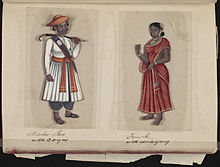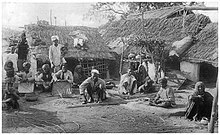Kasta


Kasta je unutar sebe zatvorena društvena skupina zasnovana na porodičnom nasleđu i strogoj hijerarhiji moći i uticaja. Kastinska organizacija društva još uvek delom egzistira na indijskom potkontinentu. Kasta je oblik društvene stratifikacije koju karakteriše endogamija, nasledni prenos stila života koji često uključuje zanimanje, ritualni status u hijerarhiji i uobičajenu društvenu interakciju i isključenost zasnovanu na kulturnim shvatanjima čistoće i zagađenja.[1][2][3] Njen paradigmatski etnografski primer je podela indijskog hinduističkog društva na krute društvene grupe, sa korenima u drevnoj istoriji Indije i postojanim do danas.[1][4] Međutim, ekonomski značaj kastinskog sistema u Indiji opada kao rezultat urbanizacije i programa afirmativnih akcija. Kao predmet znatnog proučavanja sociologa i antropologa, hinduistički kastni sistem ponekad se koristi kao analogna osnova za proučavanje društvenih podela sličnih kastama koje postoje izvan hinduizma i Indije. Izraz „kasta” takođe se primenjuje na morfološke grupe kod eusocijalnih insekata kao što su mravi, pčele i termiti.[5]
Etimologija
[uredi | uredi izvor]The English word "caste" (/kɑːst, kæst/) derives from the Spanish and Portuguese casta, which, according to the John Minsheu's Spanish dictionary (1569), means "race, lineage, tribe or breed".[6] When the Spanish colonised the New World, they used the word to mean a "clan or lineage". It was, however, the Portuguese who first employed casta in the primary modern sense of the English word 'caste' when they applied it to the thousands of endogamous, hereditary Indian social groups they encountered upon their arrival in India in 1498.[6][7] The use of the spelling "caste", with this latter meaning, is first attested in English in 1613.[6]
Opis
[uredi | uredi izvor]Podela indijskog društva na kaste ili varne, čije etimološko značenje se odnosi na boju kože, potiče od indoevropskog naroda, starih Arijevaca. Iako se kastinski sistem u Indiji menjao u istorijsko - političkim prevratima, drevni sistem verovanja da su svi ljudi rođeni nejednaki, jači je i od savremenog zakona i indijskog ustava, koji zabranjuje kastinsku diskriminaciju i ukida nedodirljivost. Međutim, hinduizam, koji je religija oko 80 odsto indijskog stanovništva, i dalje utiče na svakodnevni život, a većina ljudi se i dalje upravlja krutom hijerarhijom i društvenim kodeksima, koji su nasleđeni iz davnih bramanskih vremena.
Podela
[uredi | uredi izvor]Na vrhu kastinskog poretka u Indiji nalazili su se bramani, stalež sveštenika i učitelja, koji je imao najveći ugled. Oni su bili zaduženi za tumačenje verskih tekstova i vođenje obreda, a visoko obrazovanje im je omogućavalo bavljenje zakonodavnim i pravosudnim poslovima i podučavanjem. Ratnici i plemstvo, čine drugu kastu, kšatrije. Oni predstavljaju svetovnu moć, a njihov zadatak je da vladaju i štite zemlju od neprijatelja. Treću kastu čini slobodno arijevsko proizvodno stanovništvo, naseljenici koji su ostali čiste rase, vajšije. To su obično trgovci, zemljoradnici i odgajivači stoke, koji su snabdevali ostale kaste osnovnim životnim namirnicama. Četvrtu kastu su činili nearijevci, šudre. Ona se sastojala od porobljenog, tamnoputog dravidskog populacije i socijalno odbačenih arijevaca, koji su se pomešali sa potlačenim starosedeocima. Pošto su bili bez poseda obavljali su najteže fizičke poslove kao, nadničari, sluge i podanici 3 gornje kaste. Parije, "nedodirljivi" (od parija su potekli Cigani koji imaju istu etimologiju kao i status nedodirljive kaste), bili su potpuno izbačeni iz kastinskog poretka i smatrani su nedostojnim života u zajednici zbog poslova koje su obavljali. I danas su parije osuđene na najteže i takozvane "nečiste" poslove u skladu sa njihovim ciganstvom, koji se prenose sa generacije na generaciju, a predrasude određuju njihove živote, naročito u ruralnim područjima gde živi skoro tri četvrtine indijskog stanovništva.
Reference
[uredi | uredi izvor]- ^ a b
- Lagasse, Paul, ur. (2007), „Caste”, The Columbia Encyclopedia, New York, NY: Columbia University Press, ISBN 978-0-231-14446-9, Pristupljeno 24. 9. 2012 Quote: "caste [Port., casta=basket], ranked groups based on heredity within rigid systems of social stratification, especially those that constitute Hindu India. Some scholars, in fact, deny that true caste systems are found outside India. The caste is a closed group whose members are severely restricted in their choice of occupation and degree of social participation. Marriage outside the caste is prohibited. Social status is determined by the caste of one's birth and may only rarely be transcended."
- Madan, T. N.; Editors (2012), caste, Encyclopæida Britannica Online Quote: "caste, any of the ranked, hereditary, endogamous social groups, often linked with occupation, that together constitute traditional societies in South Asia, particularly among Hindus in India. Although sometimes used to designate similar groups in other societies, the "caste system" is uniquely developed in Hindu societies."
- Gupta, Dipankar (2008), „Caste”, Ur.: Schaefer, Richard T., Encyclopedia of Race, Ethnicity, and Society, Thousand Oaks: SAGE, str. 246—250, ISBN 978-1-4129-2694-2, Pristupljeno 5. 8. 2012 Quote: "Caste: What makes Indian society unique is the phenomenon of caste. Economic, religious, and linguistic differentiations, even race-based discrimination, are known elsewhere, but nowhere else does one see caste but in India."
- Béteille 2002, str. 136–137. Quote: "Caste: Caste has been described as the fundamental social institution of India. Sometimes the term is used metaphorically to refer to rigid social distinctions or extreme social exclusiveness wherever found, and some authorities have used the term 'colour-caste system' to describe the stratification based on race in the United States and elsewhere. But it is among the Hindus in India that we find the system in its most fully developed form although analogous forms exist among Muslims, Christians. Sikhs and other religious groups in South Asia. It is an ancient institution, having existed for at least 2,000 years among the Hindus who developed not only elaborate caste practices hut also a complex theory to explain and justify those practices (Dumont 1970). The theory has now lost much of its force although many of the practices continue."
- Mitchell, Geoffrey Duncan (2006), „Castes (part of SOCIAL STRATIFICATION)”, A New Dictionary of the Social Sciences, New Brunswick, NJ: Aldine Transaction Publishers, str. 194—195, ISBN 978-0-202-30878-4, Pristupljeno 10. 8. 2012 Quote:"Castes A pure caste system is rooted in the religious order and may be thought of as a hierarchy of hereditary, endogamous, occupational groups with positions fixed and mobility barred by ritual distances between each caste. Empirically, the classical Hindu system of India approximated most closely to pure caste. The system existed for some 3,000 years and continues today despite many attempts to get rid of some of its restrictions. It is essentially connected with Hinduism."
- „caste, n.”, Oxford English Dictionary, Second edition; online version June 2012, Oxford, UK: Oxford University Press, 1989, Pristupljeno 5. 8. 2019) Quote: "caste, n. 2a. spec. One of the several hereditary classes into which society in India has from time immemorial been divided; ... This is now the leading sense, which influences all others."
- ^ Scott & Marshall 2005, str. 66.
- ^ Winthrop 1991, str. 27–30.
- ^ Béteille 2002, str. 66.
- ^ Wilson, E. O. (1979). „The Evolution of Caste Systems in Social Insects”. Proceedings of the American Philosophical Society. 123 (4): 204—210. JSTOR 986579.
- ^ a b v „caste”. Oxford English Dictionary (3rd izd.). Oxford University Press. septembar 2005. (Potrebna je pretplata ili članska kartica javne biblioteke UK.)
- ^ Pitt-Rivers, Julian (1971), „On the word 'caste'”, Ur.: T O Beidelman, The translation of culture essays to E.E. Evans-Pritchard, London, UK: Tavistock, str. 231—256, GGKEY:EC3ZBGF5QC9
Literatura
[uredi | uredi izvor]- Ovaj članak ili njegov deo izvorno je preuzet iz Rečnika socijalnog rada Ivana Vidanovića uz odobrenje autora.
- Béteille, André (2002), „Caste”, Ur.: Barnard, Alan; Spencer, Jonathan, Encyclopedia of Social and Cultural Anthropology, New York; London: Routledge, str. 136—137, ISBN 978-0-415-28558-2
- Doniger, Wendy, ur. (1999), „Caste”, Merriam-Webster's Encyclopedia of World Religions
 , Springfield, MA: Merriam-Webster, str. 186, ISBN 978-0-87779-044-0, Pristupljeno 24. 9. 2012
, Springfield, MA: Merriam-Webster, str. 186, ISBN 978-0-87779-044-0, Pristupljeno 24. 9. 2012 - Gupta, Dipankar (2008), „Caste”, Ur.: Schaefer, Richard T., Encyclopedia of Race, Ethnicity, and Society, Thousand Oaks: Sage, str. 246—250, ISBN 978-1-4129-2694-2, Pristupljeno 5. 8. 2012
- Lagasse, Paul, ur. (2007), „Caste”, The Columbia Encyclopedia, New York: Columbia University Press, ISBN 978-0-231-14446-9, Pristupljeno 24. 9. 2012
- Madan, T. N.; Editors (2012), caste, Encyclopæida Britannica Online
- Mitchell, Geoffrey Duncan (2006), „Castes (part of Social Stratification)”, A New Dictionary of the Social Sciences, New Brunswick, NJ: Aldine Transaction Publishers, str. 194—195, ISBN 978-0-202-30878-4, Pristupljeno 10. 8. 2012
- Morris, Mike (2012), „caste”, Concise Dictionary of Social and Cultural Anthropology, Malden, MA: John Wiley & Sons, str. 33, ISBN 978-1-4443-3209-4, Pristupljeno 10. 8. 2012
- Nagar, Richa (2011), „caste”, Ur.: Derek Gregory, The Dictionary of Human Geography, Ron Johnston, Geraldine Pratt, Michael Watts, Sarah Whatmore, John Wiley & Sons, str. 72, ISBN 978-1-4443-5995-4, Pristupljeno 10. 8. 2012
- Oxford English Dictionary („caste, n.”, Oxford English Dictionary, Second edition; online version June 2012, Oxford, UK: Oxford University Press, 1989, Pristupljeno 5. 8. 2012) Quote: caste, n. 2a. spec. One of the several hereditary classes into which society in India has from time immemorial been divided; ... This is now the leading sense, which influences all others.
- Parry, Jonathan (2003), „Caste”, Ur.: Kuper, Adam; Kuper, Jessica, Social Science Encyclopedia, London and New York: Routledge, str. 131, ISBN 978-0-415-28560-5
- Pavri, Firooza (2004), „Caste”, Ur.: Tim Forsyth, Encyclopedia of International Development, Abingdon, Oxon; New York: Routledge, str. 63–, ISBN 978-0-415-25342-0
- Ramu, G. N. (2008), „Caste”, Ur.: William A. Darity, International Encyclopedia of the Social Sciences, (Macmillan social science library), Detroit, MI: Macmillan Reference US, ISBN 978-0-02-865967-1, Pristupljeno 24. 9. 2012
- Roberts, Nathaniel P. (2008), „Anthropology of Caste”, Ur.: William A. Darity, International Encyclopedia of the Social Sciences, Macmillan social science library, Detroit, MI: Macmillan Reference US, ISBN 978-0-02-865967-1, Pristupljeno 24. 9. 2012
- Salamone, Frank A. (1997), „Caste”, Ur.: Rodriguez, Junius P., The Historical Encyclopedia of World Slavery, Volume 1, Santa Barbara, CA; Oxford, UK: ABC-CLIO, str. 133, ISBN 978-0-87436-885-7, Pristupljeno 5. 8. 2012
- Scott, John; Marshall, Gordon (2005), „caste”, A Dictionary of Sociology, Oxford; New York: Oxford University Press, str. 66, ISBN 978-0-19-860987-2, Pristupljeno 10. 8. 2012
- Sonnad, Subhash R. (2003), „Caste”, Ur.: Christensen, Karen; Levinson, David, Encyclopedia of Community: From the Village to the Virtual World, Thousand Oaks, CA: Sage, str. 115—121, ISBN 978-0-7619-2598-9, Pristupljeno 5. 8. 2012
- Sooryamoorthi, Radhamany (2006), „Caste Systems”, Ur.: Leonard, Thomas M., Encyclopedia of the Developing World, New York: Routledge, str. 252—, ISBN 978-0-415-97662-6, Pristupljeno 5. 8. 2012
- Winthrop, Robert H. (1991), Dictionary of Concepts in Cultural Anthropology, ABC-CLIO, str. 27—30, ISBN 978-0-313-24280-9, Pristupljeno 10. 8. 2012
- Spectres of Agrarian Territory by David Ludden 11 December 2001
- "Early Evidence for Caste in South India", pp. 467–492 in Dimensions of Social Life: Essays in honour of David G. Mandelbaum, Edited by Paul Hockings and Mouton de Gruyter, Berlin, New York, Amsterdam, 1987.
Spoljašnje veze
[uredi | uredi izvor]- Casteless
- Auguste Comte on why and how castes developed across the world – in The Positive Philosophy, Volume 3 (see page 55 onwards)
- Robert Merton on Caste and The Sociology of Science
- Caste, Society and Politics in India from the Eighteenth Century to the Modern Age – Susan Bayly
- Class In Yemen by Marguerite Abadjian (Archive of the Baltimore Sun)
- International Dalit Solidarity Network: An international advocacy group for Dalits
